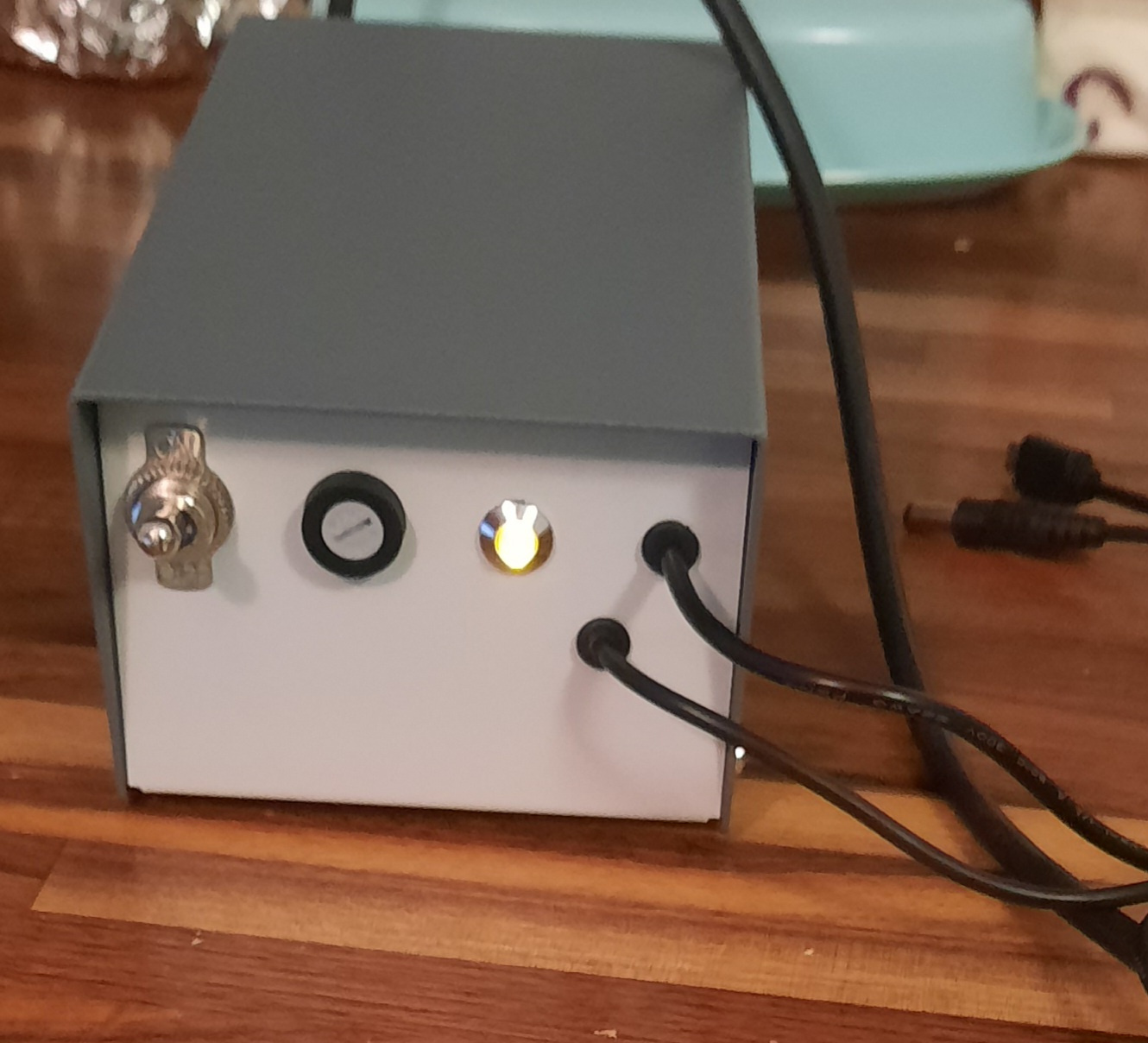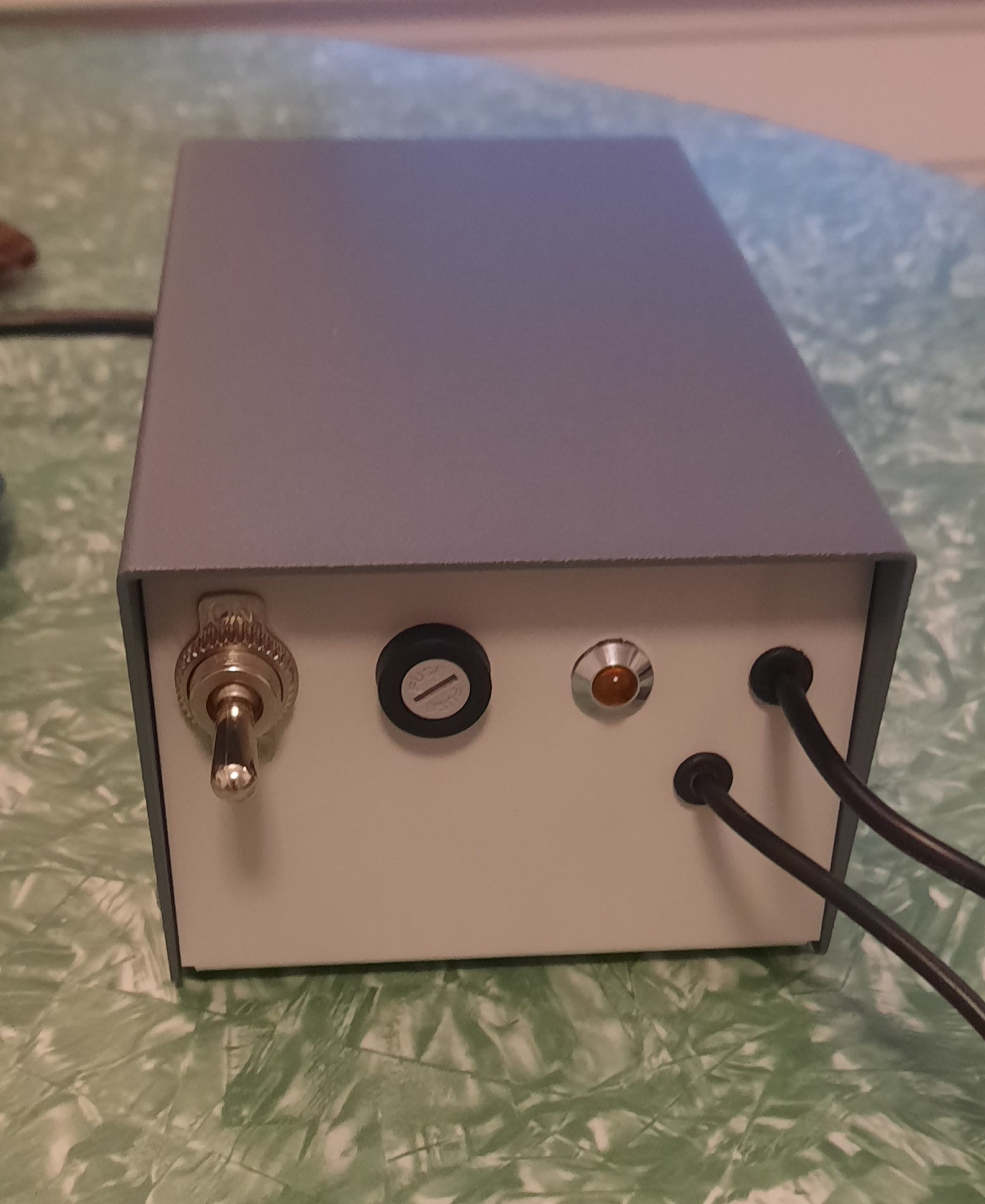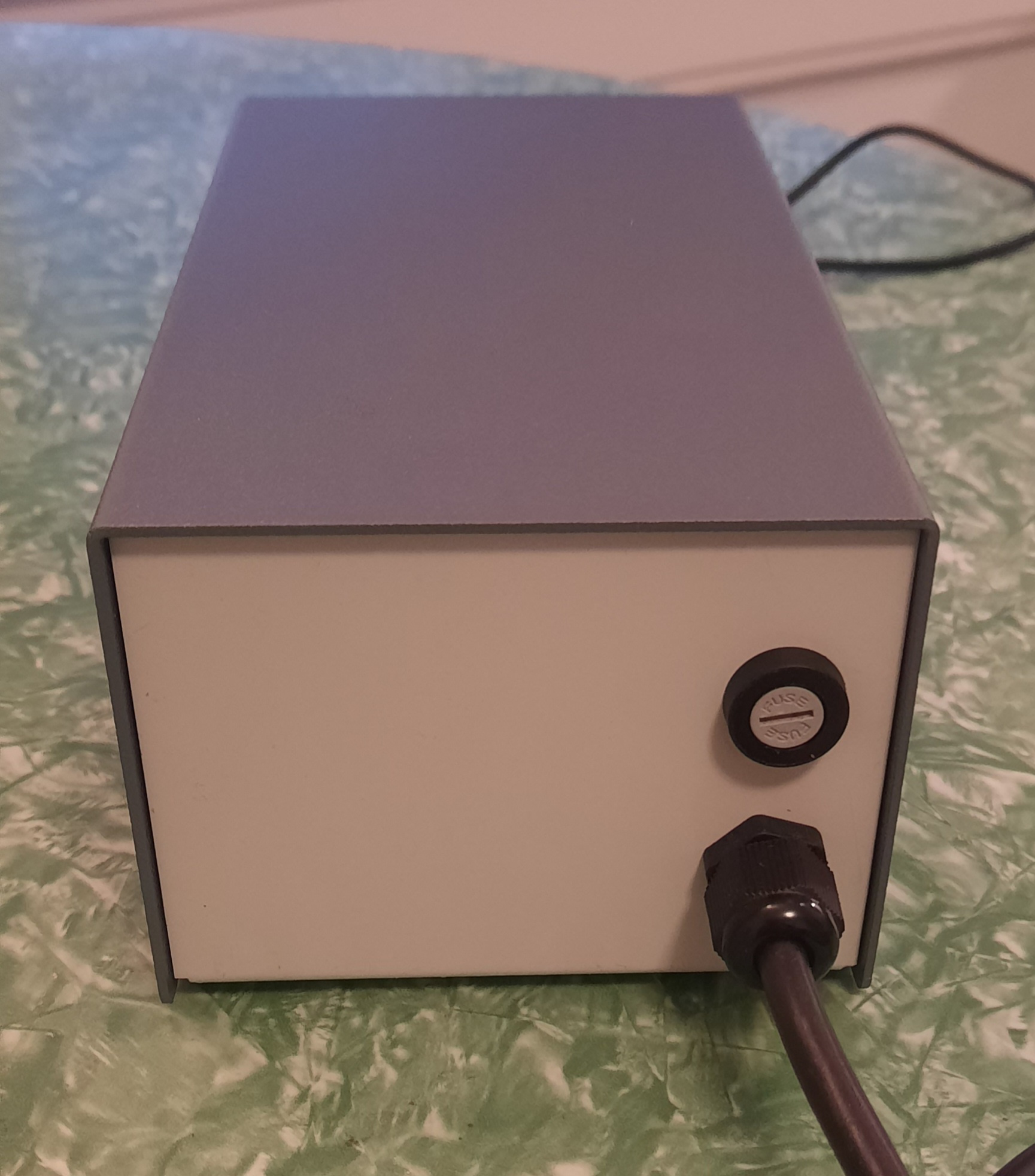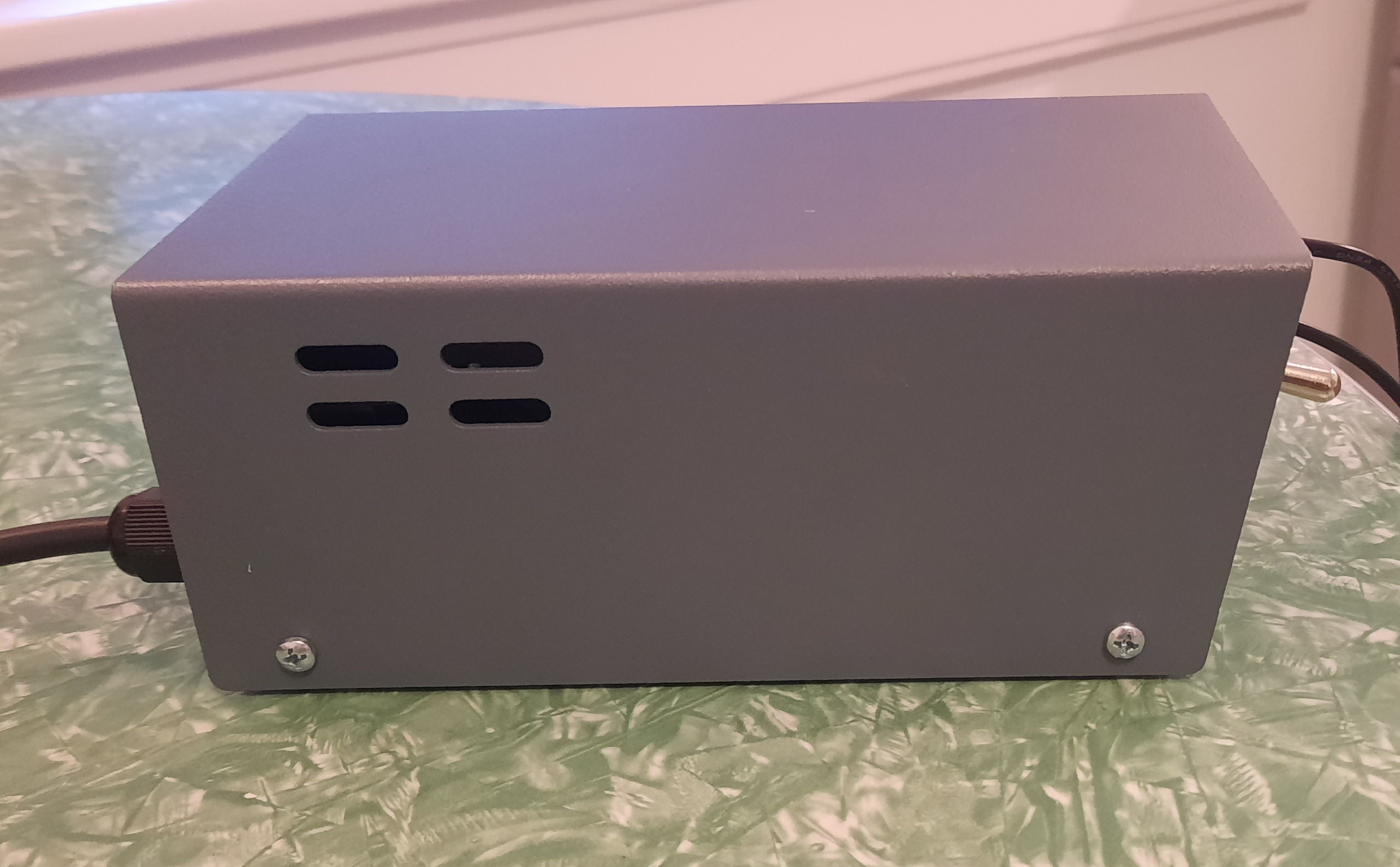My power supply setup
Got my power supply set up, just wanted to share what I did.
This is/will be used to power my KiwiSDR2 and a TP-Link TL-WR802N. Both will eventually be set up at my remote/2nd QTH where I won't be able to access them easily all the time.
The 802N (2.4 ghz ONLY) version seems to only use about 0.2-0.3A once running. Both combined seem to run around 1A once booted up. I put a delay board in (as posted elsewhere here) to wait 30 seconds before the Kiwi gets power. This lets the power supply get started, and the TP-Link Wifi gets going a bit before the Kiwi starts drawing power.
The main power supply portion is an Acopian 5EB250 from ebay. This is a 5V, 2.5A linear power supply completely encapsulated and rated to 70C. Used a Hammond 511-0900 vented case to mount it inside of. Fused both sides, added a switch, an LED, and then the 5V relay/delay board. The delay board relay must be NC, as it flashes the Kiwi for an instant when power comes on, then the relay opens the power connection. I'll live with that as I only plan to cycle power due to occasional outages once I get it set up at my cabin. (About 3-4x a year, it seems.)
I have enough headroom to add a tiny 5V fan to the Hammond case vent if I find it's getting too hot....I'll set it up an monitor a bit. If it is, I'll add the fan and an inline thermostat/switch.
Not the cheapest setup, but should be robust. And I'll be able to power cycle both my Kiwi and the Wifi link remotely via a Wifi controlled power strip should the need arise.
-Nate R
N8BTR





Comments
Hello,
very beautiful creation and well designed, well thought out. There is a lot of security and that's good. Sharing the constructions and achievements of each of us interests me very much. We learn some good ideas there. Thank you very much,
Maybe you can add a mains filter. There's never enough. I use this one, it has two stages:
https://fr.rs-online.com/web/p/filtres-secteurs/0292947
https://docs.rs-online.com/9f64/0900766b81523b7a.pdf
best regards, Philippe
Philippe,
Thanks for your thoughts! Excellent point about the mains filter.... I plan to add one elsewhere in the line.
My KiwiSDR and Ham radio items will probably reside in a shed at my cabin....and I'm thinking of putting a mains filter on the one AC circuit that will come into the shed.
I use a 7.5-0-7.5 volt center tapped 100VA transformer rectifier 20,000uF filtering & linear regulator 7805+ 2 power transistors good for 5 amps & 5 volts, with RFI mains filter all in a metal box containing KIwiSDR unit and RF filtered ethernet connector, bit old school overkill but works great.
My linear power supply unit. It has three channels of 5 volts, 3 amps for 3 SDR receivers. There is also one 12 volt 1 amp channel to power the active antenna and the 4G router Mikrotik.
https://youtube.com/shorts/Dswvzx9EYb0?feature=share
Nice build.
If you haven't already, please consider installing a simple SCR overvoltage crowbar circuit to each individual supply rail.
At some point in the future, you will be thanking me for prompting you to do it.
One of four linear power supplies, that I recently deployed on a remote site, has already failed and the crowbar I added saved the day by blowing a fuse when the regulator failed, and produced a dangerously high voltage at the DC output.
Regards,
Martin
Martin, thank you! Of course, I'm going to make protection against increased voltage at the output. And also a time relay with a power delay. I use a linear stabilizer LM1084 or something from this series. But it's been half a year, and I don't have time for this! May be the moust simple variant is to use 6v supressors?
I used traditional transistor, LT1083 and LM338 regulator circuits, but it was the decrete transistor circuit that failed in my case.
A lot depends upon what voltage and short circuit fault current is likely to be able to be supplied by the power supply raw DC rail, and if your protection device is sufficiently rated to withstand it.
I used a S4025L 400V 25A Thyristor / SCR, a couple of other components and a suitable value Zenner diode.
Something like this type of circuit topology.
Regards,
Martin
Updates: Found this Acopian 2.5A module runs pretty hot. Talked to Acopian, and then meaured my current consumption more closely. They confirmed the 5EB250 is the hottest of their encapsulated supplies....but also would be fine, exactly what it was designed for, etc. (It's rated to run up to 70C ambient at the full 2.5A rating)
With my KiwiSDR2, the delay board, and the TP-Link WR802N v4, I saw about 930 ma peak. Took a 10 minute video of my Fluke meter readings through startup, logging on, running WSPR, FT8 and a stream or 2. Now maybe there's short startup spikes higher than that which my meter is missing, but once running, I'm using under 1A, even with the CPU on the beagle loaded down to 80+%.
Acopian makes 5V models at 0.5, 1, 1.5, 2 and 2.5A. They have the same footprint, just different heights. So I bought a 1.5A model on Ebay and swapped it out. That one seems to work OK, and runs somewhat cooler than the 2.5A version did. I've installed software updates where the BB is at 98% CPU, etc....no issues. But, if I ever need to go to the updated/current TP-Link Wifi bridge model, I'll need more current..... Or if I want to add a 5V fan....
I later added a 40x40x20 heatsink to the top, just because I had the room and it would help a tad.
I also bought an over voltage protection board on ebay that's a mere 5.4 x 11mm..just in case the PS ever fails and sends higher voltage out. I soldered the OVP to the Kiwi power only...easy enough. If the voltage exceeds 5.5V, it shuts off the output. Pic before I put heat shrink tubing over it:
Ebay link: https://www.ebay.com/itm/315042556644?var=613522398321
Summary: You MAY be able to get away with the Acopian 5EB150 rated at 1.5A, but if I were starting over, I'd get the 2A model and not the 2.5A I originally had, just to run a bit cooler (especially in my unconditioned shed that will hit 36C+) and use a bit less power as waste heat. In a conditioned space, the 5EB250 would run warm, but I didn't like how warm it was getting in higher temperatures in unconditioned areas. Also, adding a tiny, inexpensive OVP board seemed like good insurance.
-Nate
N8BTR